TEV Jäger always develops its rotor nozzles with the aim of achieving the lowest energy loss and the highest cleaning and removal performance, while at the same time ensuring a uniform cleaning result. This philosophy applies both to the use of rotor nozzles in manual cleaning processes and in automated systems.
Through ongoing research and development, TEV Jäger utilises innovative technologies and materials to continuously improve the efficiency and performance of the rotor nozzles. This includes optimising flow dynamics, material selection and design details in order to minimise energy loss while achieving maximum cleaning efficiency.
TEV Jäger's rotor nozzles are designed to deliver a powerful and precise cleaning action, whether they are used manually or integrated into automated cleaning systems. This ensures that customers in various applications can benefit from an efficient and reliable cleaning solution that fulfils the highest standards in terms of performance and quality.





